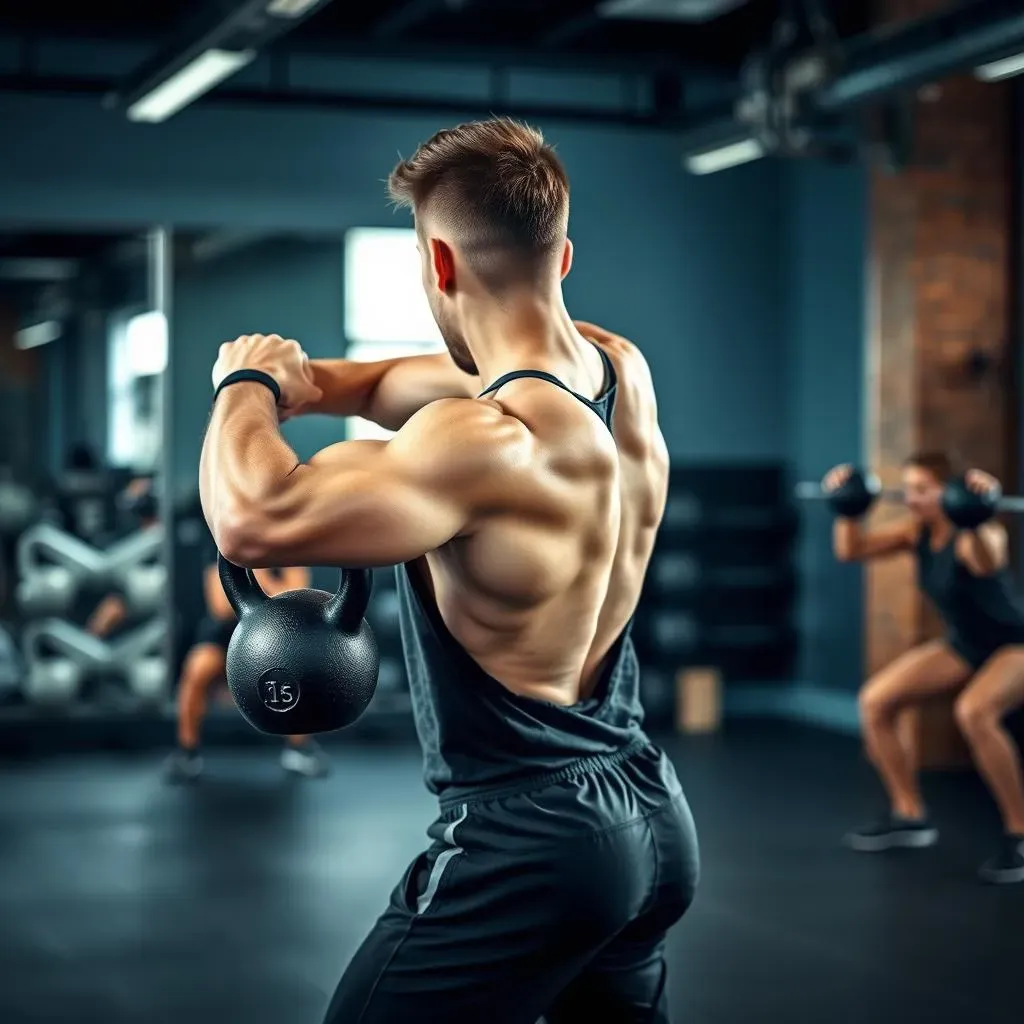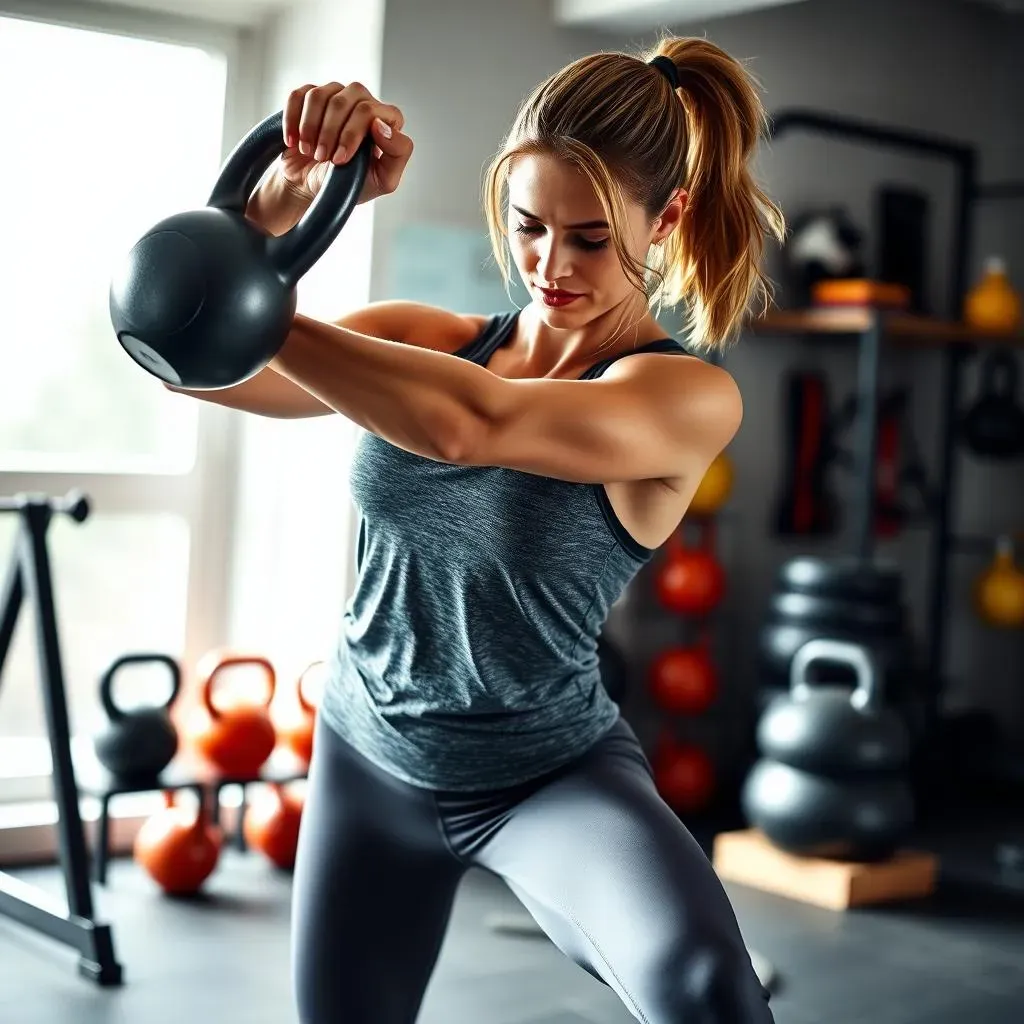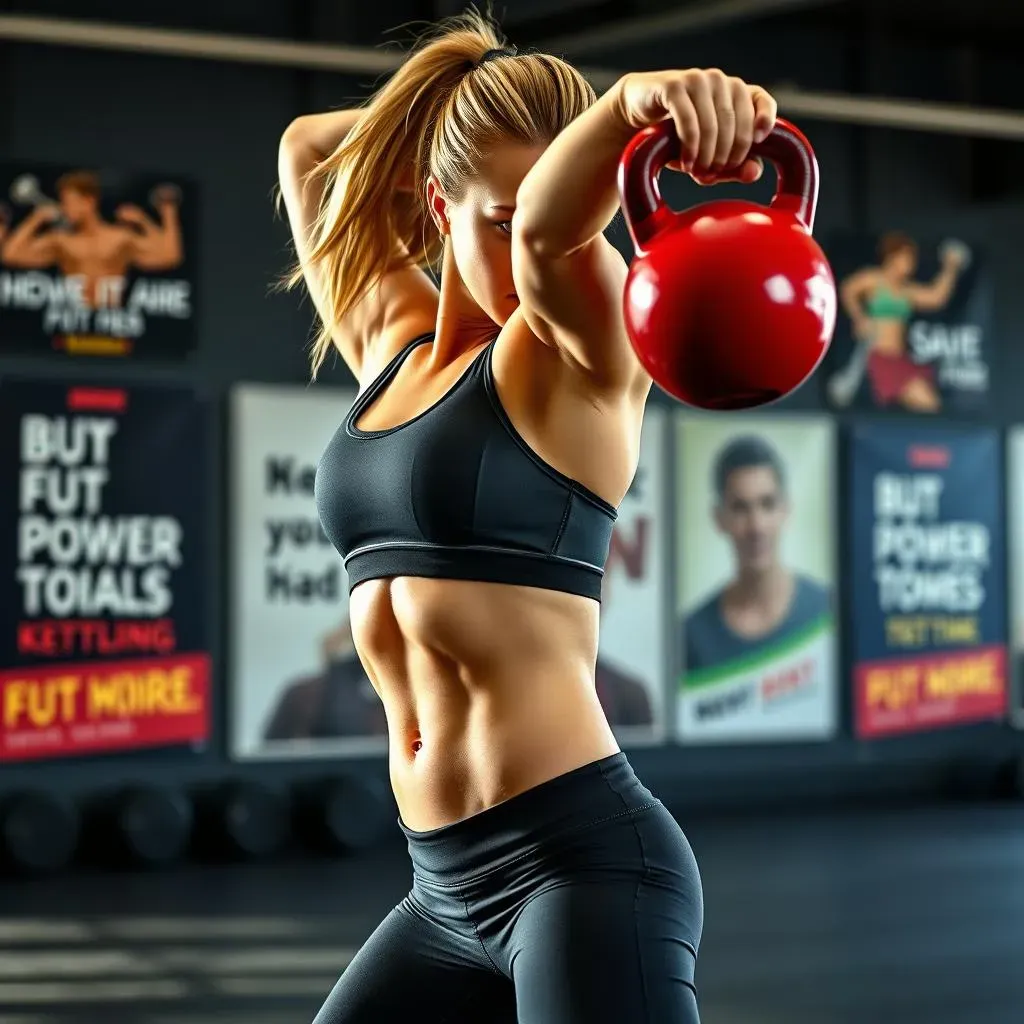Table of Contents
Ready to torch calories, build serious strength, and sculpt your physique, all from the comfort of your living room? Forget expensive gym memberships and complicated equipment. The answer lies in the power of the kettlebell. A full body home kettlebell workout is a dynamic, efficient, and incredibly effective way to achieve your fitness goals. Whether you're a seasoned athlete or just starting your fitness journey, incorporating kettlebells into your routine can unlock a new level of strength, endurance, and overall well-being.
Why Choose a Full Body Home Kettlebell Workout?

Why Choose a Full Body Home Kettlebell Workout?
Efficiency and Effectiveness
Let's face it, time is precious. Juggling work, family, and social life can leave little room for lengthy gym sessions. That's where the beauty of a full body home kettlebell workout shines. Kettlebells are like compact, portable gyms, allowing you to target multiple muscle groups simultaneously. Compound exercises, such as swings, squats, and presses, engage your entire body, maximizing calorie burn and building functional strength in minimal time. Forget spending hours isolating individual muscles; kettlebells offer a holistic approach to fitness that fits seamlessly into a busy lifestyle.
Plus, the unique offset center of gravity of a kettlebell forces your core to work overtime, improving stability and balance. This translates to real-world benefits, enhancing your performance in everyday activities and reducing the risk of injuries. It's not just about building muscle; it's about building a body that moves better, feels better, and performs at its peak.
Versatility and Accessibility
One of the greatest advantages of a full body home kettlebell workout is its versatility. With just a single kettlebell, you can perform a wide range of exercises that target every major muscle group. From strength training to cardio to mobility work, the possibilities are endless. This versatility keeps your workouts engaging and prevents plateaus, ensuring continuous progress towards your fitness goals.
Furthermore, kettlebells are incredibly accessible. Unlike bulky gym equipment, they take up minimal space and can be easily stored in a closet or under a bed. This makes them perfect for home workouts, regardless of your living situation. And with countless online resources and tutorials available, learning proper kettlebell technique has never been easier. Whether you're a beginner or an experienced lifter, a full body home kettlebell workout can be tailored to your individual needs and abilities.
Benefit | Description |
|---|---|
Full Body Engagement | Works multiple muscle groups simultaneously. |
Time Efficiency | Provides effective workouts in minimal time. |
Versatility | Offers a wide range of exercises for varied training. |
Accessibility | Requires minimal equipment and space, suitable for home workouts. |
Essential Kettlebell Exercises for a Full Body Workout

Essential Kettlebell Exercises for a Full Body Workout
The King: Kettlebell Swings
No full body home kettlebell workout is complete without the swing. It's the foundation upon which so much kettlebell training is built. The swing primarily targets your posterior chain – hamstrings, glutes, and back – but also engages your core, shoulders, and grip. It’s an explosive movement that builds power, improves cardiovascular fitness, and torches calories. Think of it as a dynamic plank, where you're constantly bracing your core to maintain stability.
Proper form is crucial for the kettlebell swing. Start with the kettlebell a few inches in front of you. Hinge at your hips, keeping your back straight, and hike the kettlebell back between your legs. Then, explosively drive your hips forward, using that power to swing the kettlebell up to chest height. Control the descent, guiding the kettlebell back between your legs. Avoid squatting down; the movement should come from your hips, not your knees.
The Hinge Master: Romanian Deadlifts (RDLs)
While the swing is dynamic, the Romanian Deadlift (RDL) is its more controlled cousin. RDLs emphasize the eccentric (lowering) phase of the movement, which is fantastic for building strength and muscle in your hamstrings and glutes. It also improves your hip hinge mechanics, which is essential for preventing lower back pain.
Hold the kettlebell in front of your thighs with an overhand grip. Keeping a slight bend in your knees, hinge at your hips, lowering the kettlebell towards the ground. Keep your back straight and your core engaged. You should feel a deep stretch in your hamstrings. Lower the kettlebell as far as you can while maintaining good form, then squeeze your glutes to return to the starting position. Focus on feeling the stretch and contraction in your hamstrings with each rep.
The Total Package: Goblet Squats
The goblet squat is a fantastic exercise for building lower body strength and improving mobility. Holding the kettlebell close to your chest encourages an upright posture, which helps to improve squat depth and reduce the risk of lower back pain. It also engages your core and upper back, making it a true full-body exercise.
Hold the kettlebell close to your chest, with your elbows pointing down. Stand with your feet slightly wider than shoulder-width apart, with your toes pointed slightly outward. Keeping your back straight and your core engaged, squat down as low as you can while maintaining good form. Aim to get your elbows between your knees. Pause at the bottom, then push through your heels to return to the starting position. Focus on maintaining an upright posture and controlling the movement throughout the entire range of motion.
Exercise | Target Muscles | Benefits |
|---|---|---|
Kettlebell Swings | Hamstrings, Glutes, Back, Core | Builds power, improves cardio, torches calories |
Romanian Deadlifts (RDLs) | Hamstrings, Glutes | Builds strength, improves hip hinge mechanics |
Goblet Squats | Quads, Glutes, Core | Builds lower body strength, improves mobility |
Crafting Your Own Full Body Home Kettlebell Workout Routine

Crafting Your Own Full Body Home Kettlebell Workout Routine
Step 1: Assess Your Fitness Level
Before jumping into a full body home kettlebell workout routine, it's crucial to honestly assess your current fitness level. Are you a complete beginner, or do you have some experience with strength training? Have you ever used kettlebells before? Understanding your starting point will help you choose appropriate exercises and weights, preventing injuries and ensuring a positive experience. If you're new to kettlebells, consider starting with lighter weights (6-8 kg for women, 8-12 kg for men) and focusing on mastering the fundamental movements before progressing to more challenging exercises.
Don't be afraid to modify exercises to fit your needs. If you can't perform a full goblet squat, try squatting to a box or chair. If you find the kettlebell swing too challenging, start with hip hinges to build strength in your posterior chain. The goal is to gradually progress over time, building a solid foundation of strength and technique. Remember, consistency is key. Even short, effective workouts performed regularly are better than sporadic, intense sessions.
Step 2: Choose Your Exercises
Now that you've assessed your fitness level, it's time to select the exercises that will make up your full body home kettlebell workout routine. Focus on choosing exercises that target all major muscle groups: legs, glutes, back, chest, shoulders, and core. The exercises we discussed earlier – swings, RDLs, and goblet squats – are excellent choices, but feel free to add other kettlebell exercises like presses, rows, and cleans to add variety and target specific muscle groups.
When selecting exercises, consider your goals. Are you primarily focused on building strength, improving cardiovascular fitness, or burning fat? If you want to build strength, focus on lower rep ranges (6-8 reps) with heavier weights. If you want to improve cardiovascular fitness, focus on higher rep ranges (12-15 reps) with lighter weights and shorter rest periods. And if you want to burn fat, incorporate a mix of strength and cardio exercises into your routine. The key is to find a balance that works for you and keeps you motivated.
Workout Goal | Rep Range | Weight | Rest |
|---|---|---|---|
Strength Building | 6-8 reps | Heavier | Longer (90-120 seconds) |
Cardiovascular Fitness | 12-15 reps | Lighter | Shorter (30-60 seconds) |
Fat Burning | Mix of rep ranges | Moderate | Moderate (60-90 seconds) |
Step 3: Structure Your Workout
With your exercises chosen, it's time to structure your full body home kettlebell workout routine. There are many different ways to structure a workout, but a simple and effective approach is to perform 3-4 sets of each exercise, resting for 60-90 seconds between sets. You can also incorporate supersets, where you perform two exercises back-to-back with no rest in between, followed by a rest period. This can save time and increase the intensity of your workout.
When designing your workout, consider the order of exercises. It's generally best to start with compound exercises that target multiple muscle groups, such as swings and squats, followed by isolation exercises that target specific muscles, such as bicep curls and triceps extensions. This allows you to prioritize the most demanding exercises when you're fresh and energized. Also, don't forget to warm up before your workout and cool down afterward. A proper warm-up will prepare your body for exercise, while a cool-down will help to reduce muscle soreness and improve recovery.
Full Body Kettlebell Workout: Form, Safety, and Progression

Full Body Kettlebell Workout: Form, Safety, and Progression
Mastering the Movement: Prioritizing Form
Alright, you've got your kettlebell, you've chosen your exercises, and you're ready to rock your full body kettlebell workout. But hold up! Before you start swinging for the fences, let's talk about form. Proper form is absolutely crucial, not just for maximizing results, but also for preventing injuries. Think of it this way: you wouldn't drive a car without learning the rules of the road, right? The same applies to kettlebell training. Take the time to learn the correct technique for each exercise, and your body will thank you for it.
Start by watching videos and reading articles from reputable sources. Pay close attention to the details, such as posture, alignment, and movement patterns. Practice each exercise slowly and deliberately, focusing on feeling the correct muscles engage. Don't be afraid to use a mirror or record yourself to check your form. And if possible, consider working with a qualified kettlebell instructor who can provide personalized feedback and guidance. Remember, it's better to start with lighter weights and perfect your form than to lift heavy and risk injury. Quality over quantity, always!
Listen to Your Body: Avoiding Injuries
Safety is paramount when it comes to any form of exercise, and full body kettlebell workouts are no exception. Kettlebells are powerful tools, but they can also be unforgiving if used improperly. That's why it's essential to listen to your body and pay attention to any pain or discomfort you may be experiencing. Don't push through pain; stop the exercise and address the issue. It could be a sign of poor form, muscle fatigue, or even an underlying injury.
In addition to proper form, there are other steps you can take to minimize your risk of injury. Always warm up before your workout to prepare your muscles and joints for exercise. Use appropriate weights that challenge you without compromising your form. Avoid overtraining by giving your body adequate rest and recovery time. And consider incorporating mobility and flexibility exercises into your routine to improve your range of motion and prevent muscle imbalances. Remember, consistency and longevity are the goals, so prioritize safety above all else.
Safety Tip | Description |
|---|---|
Prioritize Form | Learn and practice proper technique for each exercise. |
Listen to Your Body | Pay attention to pain and discomfort, and stop if necessary. |
Warm Up and Cool Down | Prepare your body for exercise and promote recovery. |
Use Appropriate Weights | Choose weights that challenge you without compromising form. |
Beyond the Basics: Level Up Your Full Body Home Kettlebell Training

Beyond the Basics: Level Up Your Full Body Home Kettlebell Training
Advanced Kettlebell Techniques
So, you've mastered the basics of the full body home kettlebell workout – the swings, the squats, the RDLs. You're feeling stronger, fitter, and more confident than ever before. What's next? It's time to explore advanced kettlebell techniques that will challenge your body in new ways and take your fitness to the next level. We're talking about movements like snatches, cleans, Turkish get-ups, and windmills. These exercises require a higher level of skill and coordination, but the rewards are well worth the effort. Not only will you build even more strength and power, but you'll also improve your mobility, stability, and overall athleticism.
Before attempting these advanced movements, it's crucial to have a solid foundation in the basics. Make sure you can perform the fundamental exercises with perfect form before progressing to more complex techniques. Consider working with a qualified kettlebell instructor who can teach you the proper technique and provide personalized feedback. And remember to start slowly and gradually increase the weight as you become more proficient. With patience, persistence, and a willingness to learn, you'll be amazed at what you can achieve with kettlebells.
Progressive Overload: Challenging Your Body
One of the key principles of strength training is progressive overload, which means gradually increasing the demands on your body over time. This can be achieved in a variety of ways, such as increasing the weight, increasing the reps, increasing the sets, decreasing the rest periods, or changing the exercises. By continually challenging your body, you'll force it to adapt and grow stronger.
With kettlebells, there are several ways to implement progressive overload. You can gradually increase the weight of your kettlebell as you get stronger. You can also increase the number of reps you perform with each exercise. Another option is to decrease the rest periods between sets, which will increase the intensity of your workout. You can also try combining different exercises into circuits or complexes, which will challenge your cardiovascular system as well as your muscles. The key is to find new and creative ways to challenge your body and keep it guessing. This will prevent plateaus and ensure continuous progress towards your fitness goals. Here are some ideas:
- Increase weight.
- Increase reps.
- Increase sets.
- Decrease rest.
- Try new exercises.
Progressive Overload Method | Description | Example |
|---|---|---|
Increase Weight | Use a heavier kettlebell for the same exercises. | Switch from a 16kg to a 20kg kettlebell for swings. |
Increase Reps | Perform more repetitions with the same weight. | Go from 10 to 12 reps of goblet squats. |
Decrease Rest | Reduce the rest time between sets. | Cut down rest from 90 seconds to 60 seconds. |
Conclusion: Embrace the Kettlebell Revolution
Incorporating a full body home kettlebell workout into your fitness regime is more than just a trend; it's a commitment to a stronger, healthier you. From building explosive power to enhancing cardiovascular fitness and improving functional strength, the benefits are undeniable. By mastering the fundamental exercises, prioritizing proper form, and gradually increasing the intensity, you can unlock a world of fitness possibilities right in your own home. So, pick up that kettlebell, embrace the challenge, and get ready to transform your body and your life, one swing at a time.